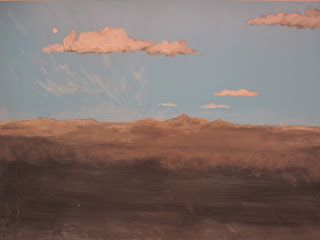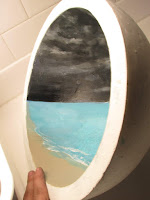The concept for this project has existed since at least the beginning of this semester, and I've made several minor pieces exploring certain aspects of it. The piece would depict the Hell Creek Formation of Late Cretaceous Montana, and certain examples of the flora and fauna within it.
By arranging, sizing, and painting the panels the way I did, from a certain angle angle and distance a viewer could experience the illusion that they were looking at an actual landscape, being forced to focus their eye on different focal lengths between the far background and foreground one at a time. I feel that I was successful in creating this illusion, and am satisfied with the way it turned out.
the initial drawing of the idea, which was mostly adhered to in the final product
panels mounted on an index card with painter's tape, but functioning as intended and proving to myselfthat the idea should work in its final form
| ||
| Panel 5: mistakenly features a mountain range that actually wouldn't have existed in that location and time period Spray paint, gesso, and acrylic paint on plexiglass |
 |
| Panels 4 and 5: Panel 4 features clusters of deciduous and ginkgo trees. Gesso and acrylic paint on plexiglass |
Panel 3: features a pair of Quetzalcoatlus near two trees
Gesso and acrylic paint on plexiglass |
 panel 2: Features a group of Thescelosaurus Gesso, acrylic paint, and pen on plexiglass | ||
|
 |
| All panels together, stacked to show size variation and amount of hidden material |
 |
| All panels together, mounted and photographed from the intended angle and distance |















































